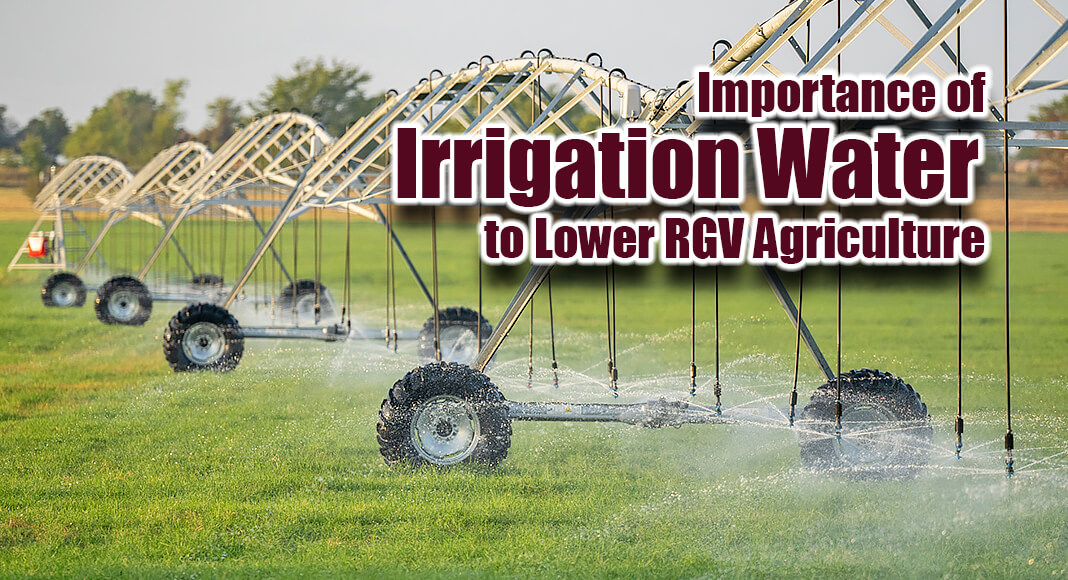
Texas Border Business
By Paul Schattenberg / paschattenberg@ag.tamu.edu
The economic impact of the complete lack of irrigation water for crop production in the Lower Rio Grande Valley in 2024 would be an estimated $495.8 million in direct revenue loss, according to a recent report by the Center for North American Studies, CNAS.
The CNAS is part of the Texas A&M College of Agriculture and Life Sciences Department of Agricultural Economics. The report is a collaborative effort by the CNAS, Texas A&M AgriLife Extension Service and Texas A&M AgriLife Research.
Luis Ribera, Ph.D., AgriLife Extension specialist in the Department of Agricultural Economics and CNAS director, said the report shows the economic impact of a “worst-case scenario” in which there would be a complete absence of irrigation water in the region.
“The past 30-plus years have demonstrated a trend toward fewer and fewer acre feet of irrigation water being available to the region,” Ribera said. “We did this report at the request of agricultural producers in the Lower Rio Grande Valley who wanted to make people aware of the dire situation they are facing now and the uncertainty of ag production in 2024 due to less irrigation water.”
He said irrigation water shortages in the region have occurred since the 1990s, exacerbated when Mexico began undersupplying the average minimum annual amount of water into the Rio Grande as required by a 1944 treaty.
“This water undersupply continues today,” Ribera said. “The water deficit for the current five-year cycle per the treaty – one that began on Oct. 25, 2020 – was 673,892 acre-feet as of Dec. 9. This represents the second largest irrigation water deficit in the last three decades.”
Importance of irrigation water to Lower Rio Grande Valley
The report shows the value of agricultural production in the Lower Rio Grande Valley region, which includes Cameron, Hidalgo, Starr and Willacy counties, was approximately $887 million in 2022.
Crop production accounted for some $673 million or about 76% of total agricultural production, consisting mainly of feed crops, cotton, vegetables, miscellaneous crops, and fruits and nuts. Livestock and agriculture-related production were about $85 million and $129 million, respectively.
According to the report, a loss of irrigated crop production in the Lower Rio Grande Valley region would lead to an estimated total loss in economic output of $993.2 million in 2024. It would also lead to a $554.8 million loss in value-added contribution to the state’s gross domestic product.
Additionally, the report states there would be the loss of an estimated 8,404 full- and part-time jobs dependent on the production and sales of the region’s agricultural commodities.
“Irrigation water is essential to agricultural production in the Lower Rio Grande Valley where about half of its crop production acreage is irrigated,” Ribera said. “This report demonstrates the necessity and value of irrigation water to crops in the region by showing the direct and indirect regional economic impact in a scenario where none of that resource would be available for crop production.”
Effect of irrigation loss on row crops
Those crops in the Rio Grande Valley affected by irrigation water shortages are row crops — mainly sorghum, cotton, corn and specialty crops — mainly vegetables, citrus and sugarcane. Row crops can be grown in either irrigated or dryland production systems; however, specialty crops can only be grown under irrigation.
The study assessed potential crop losses based on historical data. Economic impacts are estimated by measuring the change in farm gate or regional gross value of row crops and specialty crops affected by the worst-case scenario water shortage.
“With the absence of water, irrigated row crops would be assumed to produce dryland yields, causing a reduction in row crop farm-gate values,” said Samuel Zapata, Ph.D., associate professor in the Department of Agricultural Economics. Zapata works at the Texas A&M Higher Education Center at McAllen and the Texas A&M AgriLife Research and Extension Center in Weslaco. “The dryland yields used in the analysis actually provide a conservative estimate of the potential economic losses, with the total farm-gate loss for row crops estimated at $44.3 million.”
Zapata said losses would be $31.3 million, $9.4 million and $3.6 million for cotton, corn and sorghum, respectively.
Effect of irrigation loss on specialty crops
To estimate the impact of complete lack of irrigation water for specialty crops, the report divided these crops between perennial crops such as citrus and annual crops such as vegetables and sugarcane. It also makes the assumption that citrus orchards would be turned into an annual crop, with the cost of removing citrus trees at $800 per acre, as estimated by Texas Citrus Mutual.
The citrus industry in the Lower Rio Grande Valley has faced numerous challenges in recent years, including Hurricane Hanna in 2020, the crippling winter storm Uri in early 2021, plus droughts in 2022 and 2023.
“The recovering citrus industry has continued while struggling to keep orchards going due to the lack of irrigation water,” Zapata said. “But if citrus orchards had to be removed as a result of a complete loss of irrigation water, the entire citrus industry in this region would be lost.”
The report shows the economic loss due to the lack of irrigation water at the farm level — the five-year average value of citrus production in the Lower Rio Grande Valley plus the cost to transition the orchards into other uses — would amount to approximately $268.4 million.
Under the no-irrigation-water scenario, specialty vegetable crop and sugarcane production would come to a standstill. The estimated economic losses at the farm level would be the five-year average production value, some $108.5 million and $98.5 million respectively for specialty vegetable and sugarcane production.
The report, however, states the improbability that the acreage used in specialty crop production would completely remain out of crop production. Most likely, those irrigated crop acres would be converted into dryland crop production of cotton, corn or sorghum.
Broader economic effects of lack of irrigation water
The economic model used in the report was also applied to assess the broader economic effects as measured by the indicators of employment, value-added and economic output.
“This analysis represents the impacts of all economic activities that occur in the production of the described crops up until the point of sale of the crops at the farm level,” Ribera explained.
He said results in the report of the broader economic impact are also on the conservative side, as they do not include the losses that would occur beyond the farm-level sale of the crops.
“These would include losses related to transportation, storage, processing, packaging, marketing and other industries that support agriculture in the Lower Rio Grande Valley.”
Information source: Texas A&M Agrilife














